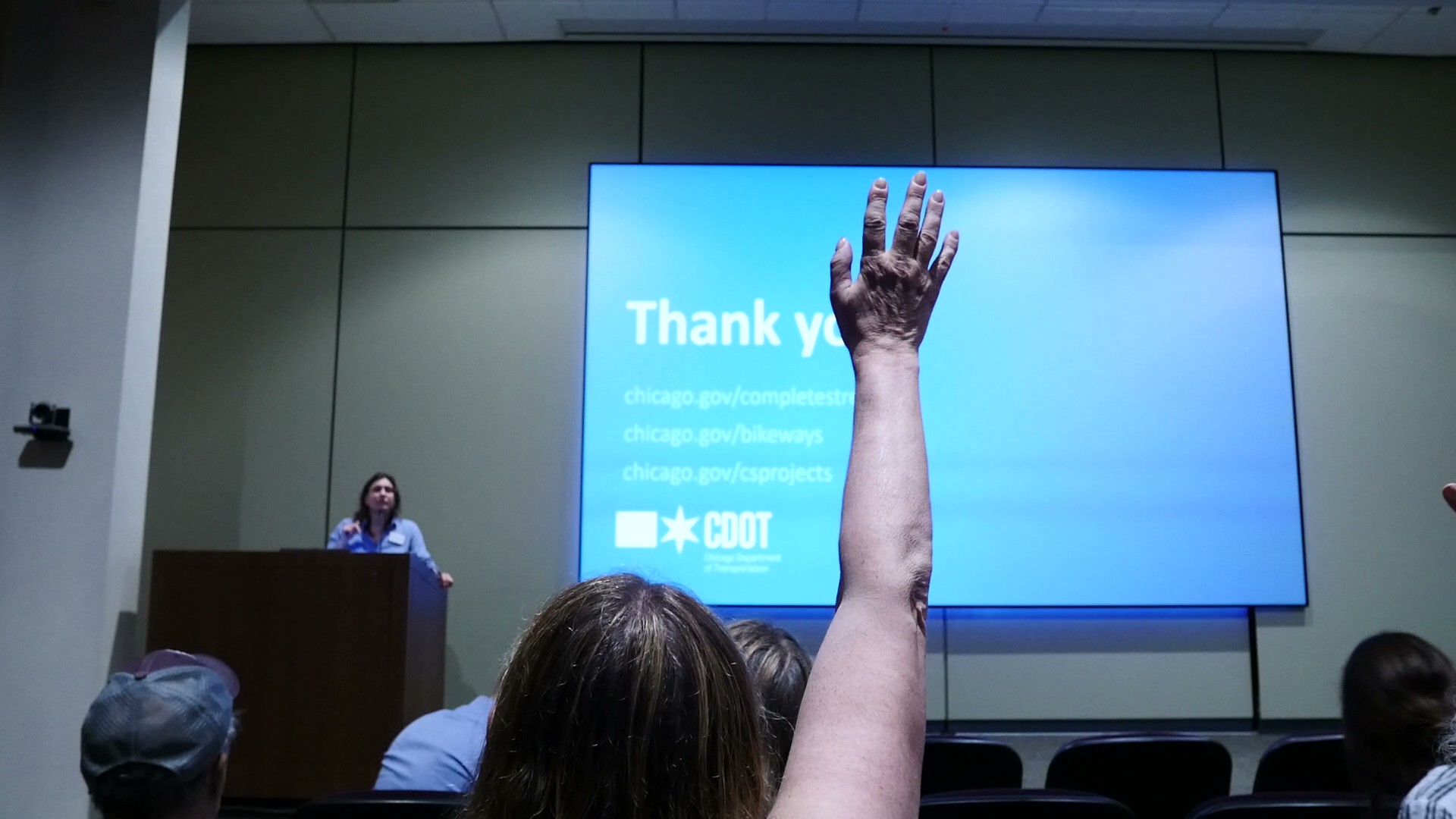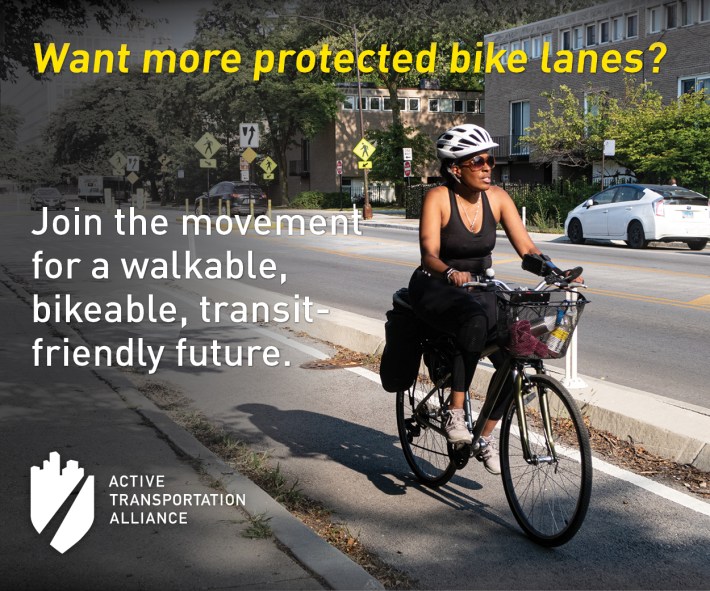
By Austin Busch
Last week, the Chicago Department of Transportation held a community meeting on the planned Wellington Neighborhood Greenway, a bike-pedestrian-priority route on Wellington Avenue (3000 N.) in Lakeview. The corridor would run 2.5 miles between Leavitt Street/Clybourn Avenue (2200 W.) and the Lakefront Trail.
The hearing at Illinois Masonic Hospital, 836 W. Wellington Ave., was jointly hosted by local alderpersons Bennett Lawson (44th) and Scott Waguespack (32nd). CDOT Program Director Amanda Woodall covered the main portion of the presentation, which at times was pointedly interrupted by attendees.
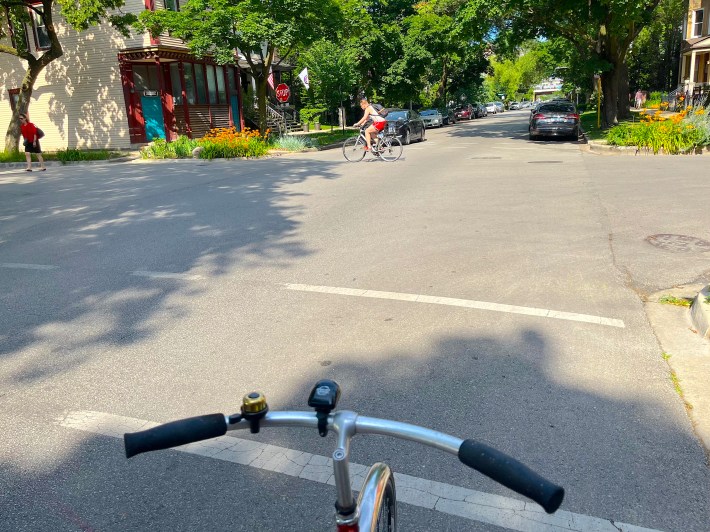
A mostly-paint project
The project’s design is minimal overall, only changing painted lane markings and signs. Traffic observations have already found low vehicle counts, significant bike use, and average driver speeds of less than 20 mph, which the project intends to "organize" through lane markings, Woodall said. No changes are planned for parking, including the locations of any existing spots, and no new concrete infrastructure is included in the project. (The project document does mention sinusoidal, bike-friendly speed humps.)
The design includes sections of contraflow bike lanes, dashed "advisory" bike lanes, and bike-and-chevron "sharrow" markings . The contraflow and advisory markings are planned for residential stretches, depending on road width. The sharrows are only slated for the section between Sheffield Avenue (1000 W.) and Clark Street (about 700 W.), in front of the hospital and adjacent to the CTA’s Wellington Brown Line station. That's the only segment with noticeably higher traffic volumes.

Though Woodall stated the project is fully designed, the aldermen expressed hesitation following pushback from attendees. "I don’t know that either one of us has signed off on the project, or if CDOT isn't looking for it," said Ald. Lawson. "I think one of the criticisms has been that CDOT will come in and put in infrastructure without talking the community. We’re not going to let that happen."
The 32nd Ward office had previously called last week's event "a Wellington Bikeway Community Engagement Meeting." which implied that CDOT would not be putting in infrastructure without talking to the community.
Ald. Waguespack likewise emphasized that his ward was still collecting feedback to influence the project. "If you think this is just done as it is, it probably isn’t," said Ald. Waguespack. "We’re cognizant whenever you make changes to the street, you have to educate people, and also make sure whether it’s pedestrian traffic, bicycle traffic, or vehicle traffic, everyone’s concerns are taken into consideration."

Installation of the Neighborhood Greenway could happen as soon as late summer or early fall of 2025, due to its minimal design. The work can be performed by in-house crews, and is funded through the overall CDOT budget, rather than aldermanic menu money. Woodall suggested that parking may not be impacted during installation, as crews could paint around the parking areas.
Why Wellington?
Wellington was chosen because it is a continuous, side-street route from Clybourn/Leavitt near the river through to the Lincoln Park green space. CDOT counted between 2,000-3,000 vehicles per day over most of the corridor, while parallel main streets such as Belmont Avenue (3200 N.) and Diversey Parkway (2800 N.) carry much higher volumes of traffic. Woodall discussed why Barry Avenue (3100 N.) wasn’t chosen instead, explaining that Barry has a complex intersection with Clark and Halsted.
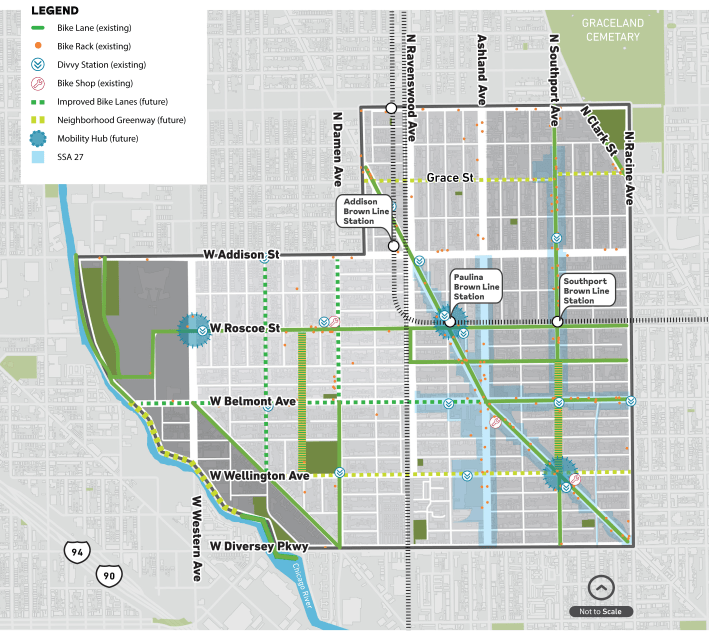
The Wellington Neighborhood Greenway was also included in the 2023 Master Plan of the Lakeview Roscoe Village Chamber of Commerce. "Additional east-west greenways should be considered along Wellington and Grace [Avenue., 3800 N.] to provide supplemental safe bike routes at greater intervals within the roadway network," stated the approved plan.
Doing a contra dance
East of Broadway (600 W.), both Barry and Wellington are eastbound one-way routes. And neither Belmont nor Diversey have dedicated bike lanes east of Halsted. So there are few safe options for riding west from the lakefront in this part of town.
A contraflow bike lane on Wellington would offer a continuous westbound route between the lakefront, the north-south Leavitt Neighborhood Greenway, and the 312 RiverRun trail.
CDOT’s traffic count found that 20-25 percent of bike riders were already traveling westbound in one-way sections of Wellington by riding against traffic. Woodall explained that contraflow markings would legalize a behavior that is already occurring and make it safer by alerting drivers to watch out for westbound bike traffic, and indicating where people on bikes should ride.
Some attendees were particularly concerned about an existing left turn lane just west of Wellington's intersection with Southport (1400 W.) and Lincoln avenues. CDOT did not provide any detailed designs of this particular intersection.
This is the intersection that was causing the commotion at the Wellington Greenway meeting.
— Milwaukee Ave Bike Lane (@milwaukeeavbike.bsky.social) 2025-07-10T00:59:19.309Z
This turn lane was installed with the recent concrete bump-out treatments at the six-way intersection, replacing a longtime installation of painted polka-dots and plastic posts. As a part of that rehab, pedestrian crossing distances were lengthened, the turning radius between Wellington and Lincoln was increased, and a lane division marking was painted within the west leg of the junction. This divided the 16-foot roadway into an eight-foot-wide left turn lane and an eight-foot-wide eastbound through lane.
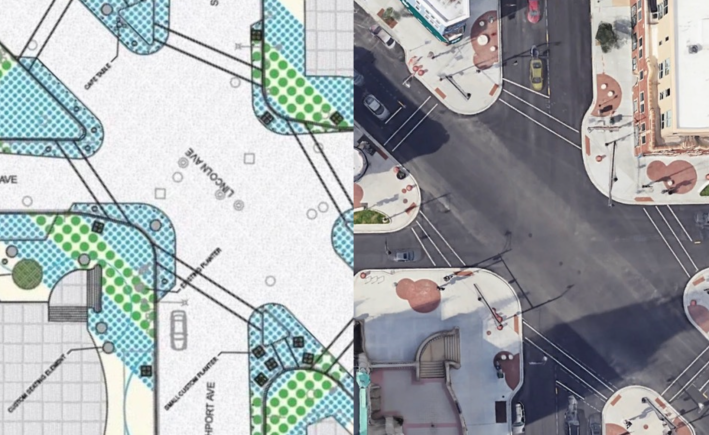
Rowdy crowd
Throughout Woodall's presentation, multiple people interrupted her by shouting. Most of them criticized elements of the project or the presentation itself. CDOT staff repeatedly asked them to hold their questions, as the department had received some questions before the meeting from the aldermen’s meeting sign-up form, and had incorporated answers into the main presentation.
Ald. Lawson eventually stepped up to the podium to ask attendees to wait for the Q & A portion. "We’re going to have a civil, respectful conversation, because that’s what we do in this community," he said. “We’re not going to shout out. We’re not going to talk over each other. We have differences of opinion in the room, that’s obvious. But we’re going to get through the presentation and then we’ll have questions."

CDOT’s presentation had attempted to use pictures of current roadway treatments from other parts of the North Side to explain the Wellington project’s different segments, though this was not well received. Attendees disputed the comparison to a stretch of Berwyn Avenue in Edgewater during the presentation, though the pictured segment is the exact same 40-foot width curb-to-curb as Wellington at Sheffield, where sharrows are due to be painted.
"The pictures you’re showing, from my perspective, are deceptive, because they’re not showing the real parts of... Wellington," said one attendee.
During the Q & A, roughly an equal number of project opponents and supporters got rowdy when someone from the other side spoke. But when Ald. Waguespack took the podium to ask attendees to be respectful, he mostly blamed the greenway proponents. "I’ve seen so many of these meetings go downhill over the last several years where people are drowning out other people for saying that people who are concerned about vehicle traffic or pedestrian traffic, and that aren’t bicyclists, should be shamed into doing something," said Ald. Waguespack. "Let’s not try to shame people for having serious concerns about anything that is affecting their daily commute."
Following a particularly contentious comment, which referred to Advocate Illinois Masonic Medical Center as "a factory," Ald. Lawson took the podium to call an end to the presentation. Attendees were invited to review the project’s map on an easel or to speak directly with CDOT staff and aldermen. Those who remained largely gathered around the aldermen to directly voice their opinions.
One attendee later pushed back on Ald. Waguespack's implication that safe streets boosters were largely to blame for the discord. Her Bluesky post below referenced another contentious discussion of the Milwaukee Avenue protected bike lanes in Bucktown back in 2023.
Alderman Waguespack snapped at me for coming to talk to him and agreeing with @lilybeansdad.bsky.social …I wasn’t even at that Milwaukee meeting and I have never met the man let alone been disrespectful at a community meeting. He clearly thinks of all people who bike as aggressive & selfish.
— foxyjewishmama (@foxyjewishmama.bsky.social) 2025-07-10T12:24:13.177Z
Supporters of the Wellington Greenway project have since created an action network petition, citing "aggressive push-back from a small but vocal minority of residents." So far, more than 800 letters have been sent.
Update 7/16/25, 6:45 PM: After the publication of this piece, CDOT spokesperson Erica Schroeder provided the following information about the project. "While new speed humps were considered, speed humps already exist on many parts of Wellington and were deemed infeasible elsewhere due to the presence of driveways or alleys," she said. "CDOT always works to ensure our projects can best meet the unique needs of each neighborhood. The project team is collecting feedback received before, during, and after last week’s community meeting, and CDOT will continue partnering with the 32nd and 44th Wards on the Wellington Greenway."
View CDOT's materials on the Wellington Greenway the Complete Streets project website.

Did you appreciate this post? Streetsblog Chicago is currently fundraising to help cover our 2025-26 budget. If you appreciate our reporting and advocacy on local sustainable transportation issues, please consider making a tax-deductible donation here. Thank you!
